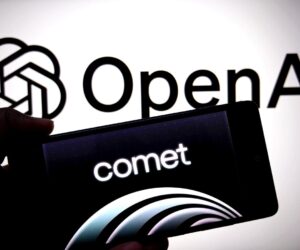Robot showing stock market financial growth chart on a black background.
getty
In the gamut of things that you could talk about around AI, most people wouldn’t pick founder/investor relationships.
However, this concept really does go to the heart of how things get done in the industry, even, and arguably even more, in the age of AI. Despite whatever ideals people have about non-commercial AI designs, much of what happens practically involves business. Academia spins up ideas, and national public sector departments like the military might pioneer certain tech, but the lion’s share of prominent AI, at least, gets touched by companies like OpenAI, Anthropic, Google, etc.
In fact, what you realize as you look at the market landscape is a certain consolidation.
Here’s a rationale put forward by Stephen Embry at Above the Law, speaking specifically about “legal tech” consolidations:
“Customers want … expanded capability,” Embry writes. “People experience the ease and time savings of AI in one place, and want it every place. But here’s the other thing customers want: simplicity. The fewer tools and platforms they have to use to get things done, the better. They want their AI tools to work seamlessly as if they were all from the same provider.”
For whatever reason, it’s happening. But despite that, there are still many smaller players in the marketplace, startups coming to market, innovators pushing the edge of AI, and so those founder/investor relationships are important.
“Think of it less like a business deal and more like a long-term marriage,” writes a professional at Funded.com. “A mismatch can lead to friction, conflicting priorities, and a breakdown in trust, which can be fatal for a young company.”
Or take this piece from Harvard Business Review, where Samantha Hellauer, Sanja Kos, Julie Vermoote and BJ Wright advise how parties can “take … steps to move from trepidation to trust.”
“The psychological DNA of many founder-leaders—characterized by self-reliance, creativity, and deep emotional investment in their businesses—sets them apart from traditional CEOs, whose acquired expertise and pattern-recognition skills are more suited to incremental growth,” authors write. So, maybe some matchmaking is in order?
Talking Business
A panel at a recent Stanford conference broke some of this down in a 30-minute discussion among moderator Krystal Hu, VC and Startup Reporter for Reuters, as well as Vijay Reddy of Mayfield, Ryan Isono of Maverick Ventures, James Detweiler of Felicis, and Tilli Kalisky-Bannett of Pinegrove Ventures Partners.
“I think everything about the job of the private market capital allocator will change because of AI. In fact, I want this to happen. I think VCs are in general pretty inefficient at allocating capital, and I think right now there are these new tools that kind of just arrive from outer space that can synthesize research, and eventually make decisions better than humans. So I’m really interested in thinking about how AI will not just help humans make decisions about how to allocate capital, but actually allocate the capital.”
“We think there will be a pretty massive consolidation, where the foundational models will be the dominant players across the entire stack,” Kalisky-Bannett said. “So they’ll continue to source hardware and infrastructure from other players, but they will be the models that will be driving a lot of the applications.”
Detailing this further, she spoke about market share dynamics.
“Foundational models (will) become more and more dominant and have more market share, they will go up the stack and provide applications themselves,” she added. “That doesn’t mean that there won’t be standalone application companies that are doing very well. We just think that there’s a pretty large risk in consolidation from the large foundational players.”
Business Strategies for a Changing World
In discussing what companies are doing to meet today’s challenges, the panel talked about how labs are approaching innovation, how to handle the “messy middle” of projects, and tips for using “forward deployed developers.”
“I think you know if you were to look back even six months ago and (see) how all the labs were attacking the application space, and you look at it now, I think it’s very clear they’re continuing to move up,” Isono said.
“If you look at the enterprise infrastructure stack right there … we don’t invest against Nvidia,” Reddy said. “There’s a lot of surface area – it’s silicon photonics, memory interconnects, that’s a place we’re very active in. As you go up the stack, when you look at models … companies like Google (and) others are extremely well capitalized and have the infrastructure to go after that space.”
Reddy also addressed human displacement.
“A lot of the workflows which humans used to do are being automated by AI, and these are not traditional SaaS replacements, but these are actual human augmentation, or human replacement in some cases,” he said. “That’s a $6 trillion economy. It’s an order of magnitude bigger than SaaS.”
Tools of the Trade
Later, the group talked about using heuristics, the nature of multi-modal LLMs, foundation models, and the evaluation of unit economics, starting to talk about founder incentives and motivations.
“If a user is paying Cursor $200 for a subscription, but Cursor is paying Anthropic $300 for the tokens, and then Anthropic is paying AWS for the cloud compute, and then AWS is paying Nvidia, there’s this supply chain which is very interesting,” Kalisky-Bannett said. “I think we as VCs, when we look at companies that are focused on the application layer, like a Cursor or Windsurf or others in the codegen space, we will be looking much more aggressively at ‘how do you scale?’ and ‘how do you scale on the unit economics front?’, and so this is relevant for any vertical or any category, and this is definitely something that I would say, if you are a founder in that space, (you should) really think about how you build a product that scales with margins that make sense.”
Talk returned to unit economics later, with Hu bringing the focus back.
“I spend a lot of my time at the seed stage, and I don’t press seed stage founders as hard on this as I do on … other things, which I think are the real scarce resources in the AI age,” Detweiler said. “Applying the Saas lens to an AI investment doesn’t work. The …. things that I think matter right now for seed stage AI companies (include) velocity. Can you ship quickly? Can you move fast? Because every week something’s changing. And even (in) the domain where you’re working, I think the half-life of a good idea to bet your career on has shrunk from a few months to a few weeks.”
Talent density, he added, counts, too.
I liked when Isono referred to “an esoteric way of living in the space.”
Then the talk moved to that issue of founder and investor dynamics.
“Given how competitive this market is, and everybody’s expecting their founders and startups to move faster, I’m curious if your dynamics, and the relationship with founders, also shifted: like, do you have to write a check faster, do due diligence faster?” Hu asked. “How is that affecting how you move in the market?”
“A partnership model is very helpful,” Reddy said, noting the value of finding founders who are “good at listening.”
“I think that that relationship is a very special relationship that will last a decade, if not more, in certain cases,” Kalisky-Bannett said. “What is most important is that there is a good relationship, and I think the best founders and the best investors will pick who they want to work with very carefully.”
Check out the video for more, including a “lightning round” where participants address more of the big trends in AI right now. The bottom line is that founders and investors working together will be powerful forces in what is still an emerging market.









